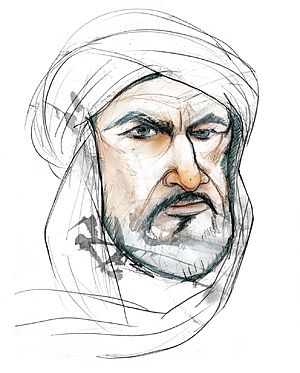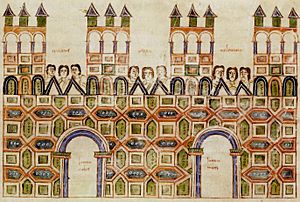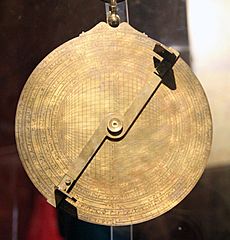Al-Zarqali facts for kids
Quick facts for kids Abū Ishaq Ibrahim al-Zarqali |
|
|---|---|

An artist's impression
|
|
| Religion | Islam |
| Personal | |
| Born | 1029 CE Toledo |
| Died | 1100 Cordoba, Al-Andalus |
| Religious career | |
| Works | Tables of Toledo |
Abū Isḥāq Ibrāhīm al-Zarqālī (born 1029, died 1100) was a brilliant Arab scientist from Al-Andalus (which is now Spain). He was an expert at making astronomical tools and studying the stars. You might also know him by his Latin name, Arzachel.
Al-Zarqālī lived in Toledo for most of his life before moving to Córdoba. His amazing work inspired many other Muslim astronomers in Al-Andalus. Later, when his writings were translated, they became very important for scientists in Europe too. He even invented a much better type of astrolabe (a tool used to measure the positions of stars and planets) called the Saphaea. This tool was so good that sailors used it for hundreds of years!
There's even a crater on the Moon named Arzachel after him.
Contents
Life of a Star Gazer
Al-Zarqālī was born in a small village near Toledo, which was an important city in Al-Andalus. He started working around 1048 for the ruler of Toledo, Al-Mamun. For 25 years, starting in 1050, Al-Zarqālī carefully watched the sun and made detailed notes.
He was originally trained as a metalsmith, someone who works with metal. Because he was so skilled at engraving metals, people called him Al-Nekkach, which means "the engraver of metals". His Latin name, 'Arzachel', comes from this Arabic name.
Al-Zarqālī was especially good at geometry and astronomy. He taught and visited Córdoba many times. His wide experience and knowledge made him one of the most important astronomers of his time. He was also an inventor, and his work helped make Toledo a major center for learning in Al-Andalus.
In 1085, the Christian king Alfonso VI took over Toledo. Al-Zarqālī and other scholars had to leave. We don't know for sure if he went to Cordoba or died in a refugee camp.
His ideas influenced many later scientists, including Nicolaus Copernicus, who is famous for saying that the Earth goes around the Sun. In the 12th century, a scholar named Gerard of Cremona translated Al-Zarqālī's works into Latin, making them available to European scholars.
Amazing Discoveries
Cool Instruments
Al-Zarqālī wrote two books about how to build a special tool called an equatorium. This tool helped calculate where planets would be in the sky using diagrams. These books were later translated into Spanish for King Alfonso X.
He also invented a much better type of astrolabe. This improved astrolabe was known as "the tablet of al-Zarqālī" or Saphaea in Europe. It was very popular and useful for many years.
There are also stories that Al-Zarqālī built a water clock. This clock could tell the time of day and night, and even show the days of the lunar months. Some historians think this might have been a different person with a similar name, but it shows the kind of clever inventions happening at the time.
Smart Ideas
Al-Zarqālī made important corrections to maps and geographical data from earlier scientists like Ptolemy. For example, he corrected Ptolemy's measurement of the width of the Mediterranean Sea from 62 degrees to the correct value of 42 degrees.
He was also the first to show that the Sun's farthest point from Earth (called the solar apogee) actually moves slowly over time. He measured this movement very accurately. This idea was later used by Copernicus in his famous book about the solar system.
Tables of Toledo
Al-Zarqālī played a big part in creating the famous Tables of Toledo. These were a collection of astronomical data that helped people find the positions of stars and planets. His own tables and almanac (a book with astronomical information for a year) were translated into Latin. This helped bring back a lot of mathematical astronomy to Christian Europe.
His almanac included tables that showed when different months began and where planets would be at any given time. It also helped predict solar and lunar eclipses. This book made it much easier to find the positions of celestial bodies without needing to do complex calculations.
Al-Zarqālī even noticed something interesting about the path of the planet Mercury. He saw that its path wasn't a perfect circle, but more like an oval shape. Some people have thought this was an early idea of Johannes Kepler's later discovery that planets move in elliptical paths. However, Al-Zarqālī didn't use this oval shape in his main calculations.
Works
Here are some of his important works:
- Al Amal bi Assahifa Az-Zijia
- Attadbir
- Al Madkhal fi Ilm Annoujoum
- Rissalat fi Tarikat Istikhdam as-Safiha al-Moushtarakah li Jamiâ al-ouroud
- Almanac Arzarchel
See also
 In Spanish: Azarquiel para niños
In Spanish: Azarquiel para niños
- Islamic astronomy
- Islamic scholars
- List of Arab scientists and scholars
|



